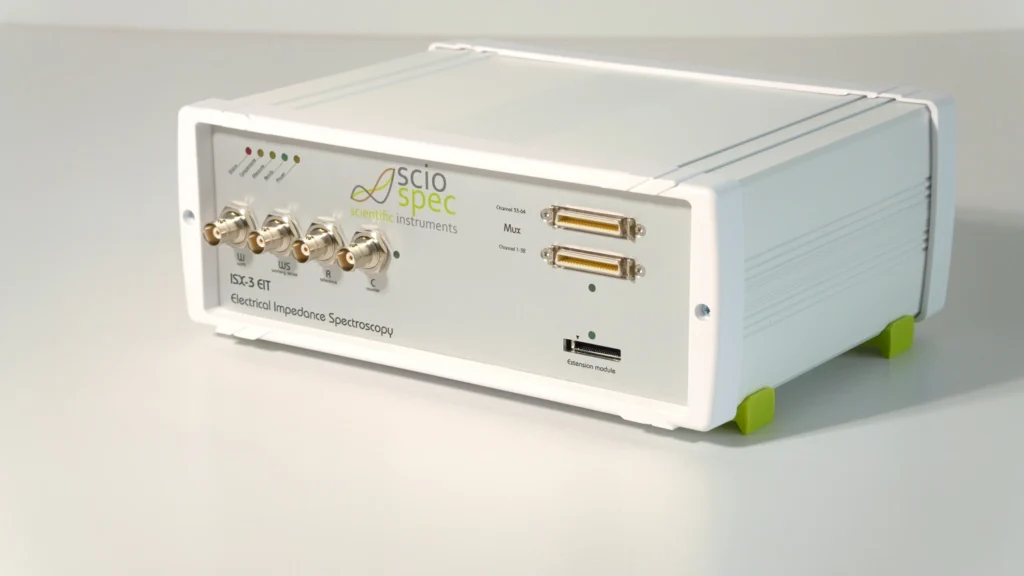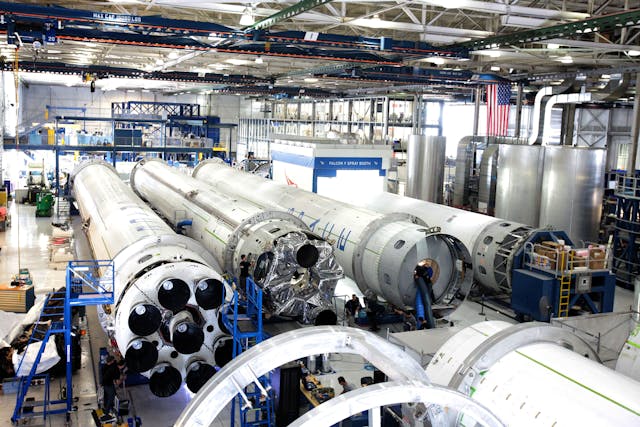Picture being able to peer inside the intricate depths of the human body, gazing through layers of tissue and even into the bustling heart of an industrial reactor. But here’s the catch – no incisions, no disruptions, just a mere glance. It may sound like something out of a sci-fi novel, but thanks to Electrical Impedance Tomography (EIT), this dream is now a reality. This non-invasive imaging technique measures electrical impedance within a medium, uncovering hidden details about its internal structure. But what exactly is EIT, and why is it causing such a stir in fields ranging from medicine to environmental monitoring?
EIT, a Safe and Non-Invasive Imaging Technique
Think of EIT as a modern-day X-ray, but instead of using potentially harmful ionizing radiation, it harnesses the power of electrical impedance. By gently applying small electrical currents through electrodes on the surface of the subject and measuring the resulting voltages, EIT can reveal the resistance to current flow within tissues or materials. The true beauty of EIT lies in its non-invasiveness – it poses no harm or interference to the medium being observed, making it a safe and versatile choice for a multitude of applications.
A Growing Demand for Advanced EIT Applications
Initially recognized for its use in real-time lung monitoring, EIT’s potential has extended far beyond traditional medical settings. With continuous advancements in technology, particularly in the precision and scalability of EIT instruments, the demand for its use has soared beyond expectations. In fact, according to Sciospec Scientific Instruments GmbH, modern EIT systems can now be equipped with up to 256 channels, offering unparalleled detail and speed in data acquisition. This has opened up endless possibilities for its application, including monitoring fluid dynamics in industrial processes, inspecting material integrity, and even enhancing security by detecting concealed objects at borders.
The Versatility of EIT: A Game-Changer for Various Industries
The versatility of EIT has captured the attention of industries seeking safer, more efficient ways to gather critical data without interrupting operations. For instance, in the pharmaceutical sector, EIT has proven invaluable in monitoring the consistency of mixtures in reactors, a delicate and vital process. And in the field of geophysics, EIT’s ability to characterize subsurface properties of geological formations has aided in resource exploration while minimizing environmental impact.
The Untapped Potential of EIT: Turning the Invisible into Visible
Ultimately, the magic of EIT lies in its ability to transform the unseen into crystal-clear imagery. As we continue to seek innovative solutions to complex problems across various disciplines, EIT stands out not only for its current contributions but also for its untapped potential. It’s this potential that fuels the increasing demand for advanced EIT applications, promising a future where our vision extends far beyond the surface, without the need for a single cut or drill.
Industrial Applications of Electrical Impedance Tomography
The realm of industrial process monitoring and control has been revolutionized by the introduction of Electrical Impedance Tomography (EIT). This innovative technique serves as a critical instrument for discerning changes within systems, such as material composition transformations in pipelines and reactors. EIT’s relevance to industry is underpinned by its capacity to offer non-invasive insights, thereby presenting a compelling alternative to traditional methods that are often costlier and less efficient.
EIT’s Role in Process Monitoring and Control
When it comes to ensuring product quality and consistency in industrial processes, EIT emerges as a key player. Its ability to detect variations in material composition is particularly valuable. For instance, in chemical processing, the presence of impurities or deviations in mixture ratios can significantly impact the final product. EIT technology, allows for real-time monitoring, which is crucial for immediate corrective actions, thus minimizing waste and reducing downtime. Such proactive oversight translates to enhanced efficiency and economic benefits for industries.
EIT in Fluidized Beds, Gas-Liquid Flows, and Mixing Processes
Fluidized beds, gas-liquid flows, and mixing processes present unique challenges due to the dynamic nature of their components. EIT provides a unique window into these processes by generating tomographic images that visualize the parameter distributions within these media. The ability to monitor these parameters in real time has significant implications for the optimization of operations, such as ensuring homogeneous mixing in pharmaceutical compounding or maintaining correct fluidization in materials processing. This level of process control not only boosts productivity but also aligns with safety standards by preventing hazardous conditions that may arise from incorrect material handling.
In the case of fluidized beds used in the petrochemical industry, for example, EIT helps in tracking the distribution and motion of solid particles. This ensures the efficient conversion of raw materials into desired products under optimal conditions. The technology’s adaptability is evident through the variety of settings in which it can be applied, from the fine-tuning of gas-liquid flow rates to achieving precise mixing ratios in composite manufacturing.
As we’ve seen, EIT is forging new paths in industrial application, offering a blend of precision, non-invasiveness, and versatility. By facilitating the continuous monitoring and control of complex processes, this technology is not just enhancing current methodologies but is also paving the way for future innovations in industrial automation and safety.
Material Characterization with Electrical Impedance Tomography
Peering beneath the surface without disturbing it, Electrical Impedance Tomography (EIT) stands out as a non-invasive technique that provides a window into the unseen—characterizing the electrical properties of materials. But how does this technology apply beyond the confines of medical diagnostics, particularly in the realm of geophysics? Let’s delve into the ways EIT helps us understand the hidden layers of our planet.
EIT shines when it comes to imaging subsurface properties, an area where traditional methods can be invasive or limited. In geophysics, for instance, researchers deploy EIT to map subsurface geological formations by measuring the natural or induced electrical conductivity variations in the Earth. These variations can indicate different types of rocks, fluids, or ores, providing valuable information for mineral exploration, groundwater studies, and environmental assessments. The ability of EIT to provide real-time images makes it an excellent tool for monitoring changes over time, such as those caused by landslides or soil erosion.
Understanding Material Composition and Behavior
The ability of EIT to discern material composition extends well beyond the dirt beneath our feet. Consider, for example, the construction industry, where EIT is instrumental in assessing the integrity of concrete. By measuring impedance, professionals can detect voids, cracks, or variations in moisture content, which are critical factors in the longevity and safety of structures.
Another striking example comes from the world of art conservation. Curators and restorers use EIT to peer into the layers of a painting or a historical monument, detecting underlying damage or the composition of different materials without laying a finger on the precious piece. This non-destructive method ensures that the integrity of these irreplaceable items is preserved while still allowing experts to conduct thorough analyses.
Furthermore, in the field of material science, EIT aids in characterizing the electrical properties of novel composites or smart materials, whose performance is essential for the development of cutting-edge technology. Whether it’s understanding the distribution of carbon nanotubes in a polymer matrix or monitoring the curing process of resins, EIT provides real-time insights into material behavior that are crucial for both research and quality control.
Real-World Examples of EIT at Work
To illustrate the practical applications of EIT, let’s consider its use in the oil and gas industry. Here, EIT systems, such as those developed by Sciospec, are employed to monitor the flow of multiphase fluids within pipelines. This information is vital for preventing blockages and optimizing flow rates, ensuring efficiency and safety in these high-stakes environments.
Picture being able to peer inside the intricate depths of the human body, gazing through layers of tissue and even into the bustling heart of an industrial reactor. But here’s the catch – no incisions, no disruptions, just a mere glance. It may sound like something out of a sci-fi novel, but thanks to Electrical Impedance Tomography (EIT), this dream is now a reality. This non-invasive imaging technique measures electrical impedance within a medium, uncovering hidden details about its internal structure. But what exactly is EIT, and why is it causing such a stir in fields ranging from medicine to environmental monitoring?
EIT, a Safe and Non-Invasive Imaging Technique
Think of EIT as a modern-day X-ray, but instead of using potentially harmful ionizing radiation, it harnesses the power of electrical impedance. By gently applying small electrical currents through electrodes on the surface of the subject and measuring the resulting voltages, EIT can reveal the resistance to current flow within tissues or materials. The true beauty of EIT lies in its non-invasiveness – it poses no harm or interference to the medium being observed, making it a safe and versatile choice for a multitude of applications.
A Growing Demand for Advanced EIT Applications
Initially recognized for its use in real-time lung monitoring, EIT’s potential has extended far beyond traditional medical settings. With continuous advancements in technology, particularly in the precision and scalability of EIT instruments, the demand for its use has soared beyond expectations. In fact, according to Sciospec Scientific Instruments GmbH, modern EIT systems can now be equipped with up to 256 channels, offering unparalleled detail and speed in data acquisition. This has opened up endless possibilities for its application, including monitoring fluid dynamics in industrial processes, inspecting material integrity, and even enhancing security by detecting concealed objects at borders.
The Versatility of EIT: A Game-Changer for Various Industries
The versatility of EIT has captured the attention of industries seeking safer, more efficient ways to gather critical data without interrupting operations. For instance, in the pharmaceutical sector, EIT has proven invaluable in monitoring the consistency of mixtures in reactors, a delicate and vital process. And in the field of geophysics, EIT’s ability to characterize subsurface properties of geological formations has aided in resource exploration while minimizing environmental impact.
The Untapped Potential of EIT: Turning the Invisible into Visible
Ultimately, the magic of EIT lies in its ability to transform the unseen into crystal-clear imagery. As we continue to seek innovative solutions to complex problems across various disciplines, EIT stands out not only for its current contributions but also for its untapped potential. It’s this potential that fuels the increasing demand for advanced EIT applications, promising a future where our vision extends far beyond the surface, without the need for a single cut or drill.
In agriculture, EIT helps farmers understand soil conditions, guiding irrigation and fertilization practices. By mapping soil moisture and salinity, EIT can inform precision farming techniques, leading to better crop yields and more sustainable land management.
Last but not least, the versatility of EIT is epitomized in its application within archaeology. Non-invasively scanning archaeological sites, EIT allows researchers to identify the location of buried artifacts, ruins, and tombs, thereby protecting our cultural heritage while unlocking the secrets of the past.
As we explore the myriad uses of Electrical Impedance Tomography, it becomes clear that this technology is not just about capturing images; it’s about gaining a deeper understanding of the materials that make up our world and harnessing this knowledge for the advancement of various industries. From beneath the Earth’s crust to the heart of our cultural artifacts, EIT proves to be an indispensable tool in our quest to characterize and comprehend the complex compositions and behaviors of diverse materials.
Biological Research Utilizing Electrical Impedance Tomography
Peering into the intricate world of biological tissues and processes, Electrical Impedance Tomography (EIT) emerges as a tool of remarkable versatility. At its core, EIT operates by gauging the electrical properties within biological specimens, from the macroscopic organs down to cellular structures. This non-invasive imaging technique extends its utility far beyond the confines of medical diagnostics, venturing into realms of pure research and offering insights into the functioning of life at a fundamental level.
Deciphering the Electrical Landscape of Biological Tissues
Within the biological sphere, EIT assumes a pivotal role in deciphering the electrical landscape that governs the behavior of tissues and organs. It’s a method that captures snapshots of physiological activities without the need for direct contact or incisions, thereby preserving the integrity of the specimen under study. Such capabilities are instrumental in applications where traditional methods might be too invasive or disruptive, such as when monitoring the real-time electrical activity in heart or brain tissues.
Unraveling the Dynamics of Muscle Contraction
One of the most intriguing applications of EIT within biological research lies in the study of muscle contraction. Muscles exhibit changes in their electrical properties during contraction and relaxation phases, and EIT is uniquely suited to monitor these dynamic shifts. By mapping the impedance variations associated with muscle movement, researchers are gaining new perspectives on neuromuscular disorders, rehabilitation strategies, and the design of biomimetic robotics that emulate the nuanced contractions of human muscles.
Cultivating Knowledge in Cell Cultures
At a finer scale, EIT shows promise in the analysis of cell cultures. Laboratory-grown cells offer a window into the cellular mechanisms that underpin health and disease, and EIT allows scientists to observe these processes as they unfold in real time. The technology can detect subtle changes in cell viability, proliferation, and differentiation, providing a non-destructive alternative to traditional assays that may require terminating the culture to obtain data.
The Frontier of 3D Organoids
Emerging frontiers in biological research, such as the cultivation of 3D organoids, are also benefiting from the application of EIT. These miniature, simplified versions of organs provide a three-dimensional model for studying complex tissue interactions, disease progression, and drug responses. EIT offers a window into the internal electrical environment of organoids, enabling researchers to investigate their inner workings without disrupting the system, thus maintaining the organoid’s integrity for continued study.
In bridging the gap between observational studies and interactive research, EIT is shaping up to be an indispensable tool in the modern biologist’s arsenal. Its non-invasive nature and detailed imaging capabilities equip researchers with a powerful means to explore life’s electrical dimensions, from the beating of a heart to the whisper of neurons.
Non-Destructive Testing (NDT) with Electrical Impedance Tomography
Imagine being able to peek inside the structural integrity of materials without so much as a scratch or a cut. That’s the magic of Non-Destructive Testing (NDT) when combined with Electrical Impedance Tomography (EIT). A technique that allows us to inspect and monitor material properties without damaging them is invaluable in numerous industries, from aerospace to civil engineering.
Inspecting Material Integrity with EIT
The core advantage of using EIT in NDT lies in its gentle approach. Unlike other methods which might require cutting into a sample or exposing it to potentially harmful radiation, EIT works by applying a small electrical current and measuring the resulting voltages around the object of interest. These measurements are then used to reconstruct an image of the interior, revealing defects like cracks, voids, or inclusions. This process can be repeated indefinitely, offering real-time monitoring capabilities that are crucial for preventive maintenance and ensuring long-term material reliability.
Real-World Examples of EIT in NDT
- Structural Health Monitoring: In civil engineering, EIT is used to detect corrosion or damage within concrete structures, helping prevent failures in bridges and buildings.
- Aerospace Component Analysis: The aerospace industry employs EIT to check for integrity in composite materials, ensuring aircraft parts are free from potentially catastrophic defects.
- Pipeline Inspection: For the oil and gas sector, EIT serves to locate build-ups or changes in composition within pipes, preventing leaks and blockages before they become larger issues.
Electrical Impedance Tomography is not just a futuristic concept; it’s a reality that’s already making waves across diverse fields. By tapping into this technology, we can gain unprecedented insights into the hidden world of material health.
Technological Frontier of EIT in NDT
With the advent of sophisticated EIT systems like those developed by Sciospec, which offer scalability up to 256 channels, the precision and resolution of NDT inspections have significantly improved. These systems enable rapid data acquisition rates through simultaneous measurements and synchronized switching, which is critical for capturing a complete picture of an object’s integrity in real-time. Such advancements are pushing the boundaries of what’s possible in NDT, allowing for more detailed analysis and early detection of potential issues.
As we look to the future, the applications of EIT in NDT are set to expand even further. The continuous development of EIT technology promises to enhance the safety, efficiency, and cost-effectiveness of inspections across various industries. With its non-invasive nature and high-resolution imaging capabilities, EIT stands as a testament to the power of innovation in maintaining the health of our engineered world.
In closing, Electrical Impedance Tomography represents a leap forward in the domain of Non-Destructive Testing. It safeguards the longevity of materials and components while upholding safety standards without inflicting harm on the subject of inspection. As we’ve explored, from monitoring the structural health of towering skyscrapers to ensuring the integrity of vital aerospace components, EIT is an indispensable ally in the quest for impeccable material quality.
Environmental Monitoring and Security Applications of Electrical Impedance Tomography
As we delve into the diverse uses of Electrical Impedance Tomography (EIT), a stand-out application is its role in environmental monitoring. Imagine being able to detect subtle changes in soil moisture content or pinpoint pollutant concentrations without so much as digging a clod of earth—this is the promise EIT holds for eco-centric studies. By measuring electrical properties within the ground, EIT offers a non-intrusive means to assess the environment’s health.
Environmental scientists can harness EIT to map out soil moisture with precision—a vital measure for agricultural health, drought assessment, and predicting natural disasters like landslides. In fact, variations in soil moisture change the electrical impedance, and by mapping these changes, EIT provides detailed visuals that guide effective land management practices. Similarly, this technology is instrumental in detecting pollutants. As contaminants often have different electrical properties compared to clean soil, EIT can reveal areas of concern, enabling early intervention to safeguard ecosystems.
Moving from soil to security, EIT also finds its place in surveillance and object imaging. The ability to image concealed objects comes in handy at airport security checkpoints or in military applications where non-invasive scanning is paramount. EIT systems, such as those developed by Sciospec, are capable of capturing real-time changes in electrical impedance, which could indicate the presence of hidden items or substances that warrant further investigation. This attribute makes it an invaluable tool in the ongoing efforts to enhance security protocols.
EIT’s versatility extends to screening scenarios as well. By monitoring material properties, EIT aids in ensuring the integrity of infrastructure or cargo, checking for irregularities that might suggest tampering or wear. For instance, in border control situations, EIT could be utilized to scan vehicles or containers efficiently, thereby streamlining the process while maintaining high safety standards.
In the context of environmental stewardship and security, EIT stands out as a multifaceted tool. It aligns with contemporary needs for sustainable monitoring methods that minimize ecological disturbance, and it enhances safety measures without compromising throughput or privacy. The seamless integration of this technology into various scenarios echoes the adaptability and sophistication of EIT systems.
Clearly, the potential applications of Electrical Impedance Tomography in environmental monitoring and security are vast and varied. By providing a non-destructive, cost-effective, and comprehensive solution, EIT is set to revolutionize how we approach these critical areas. As demand for advanced EIT capabilities grows, the technology continues to evolve, promising even more sophisticated environmental and security solutions in the future. With the advent of increasingly powerful EIT instruments, such as those with scalability up to 256 channels offered by companies like Sciospec, the scope for innovation in these fields widens even further.
As we reflect on the capabilities of EIT highlighted in this section and throughout the blog, it’s clear that whether it’s preserving our planet’s resources or safeguarding our societies, Electrical Impedance Tomography has an integral part to play. The applications described here are just the beginning, as researchers and engineers continue to push the boundaries of what this technology can achieve.
Advantages and Future Prospects of Electrical Impedance Tomography
As we reflect on the innovative applications of Electrical Impedance Tomography (EIT) explored previously, it’s clear this technology is not just a fleeting scientific novelty but rather a versatile tool with significant potential. This section delves into the multifaceted advantages EIT brings to various industries and research fields, while also considering its bright future, particularly in medical imaging and beyond.
The Versatility of EIT Across Various Domains
EIT’s adaptability is one of its most profound strengths. As cited from Sciospec, EIT systems have been pushing the boundaries in world-class research globally. From enabling precise monitoring in industrial settings to characterizing material properties in geophysics, the range of applications is vast. A notable aspect of EIT is its ability to provide real-time imaging, essential for dynamic processes like fluid flow and mixing in industrial reactors. This versatility is further amplified by Sciospec’s scalable solutions, which can accommodate up to 256 channels, catering to various complexities and sizes of the systems under study.
Medical Imaging: The Primary Use of EIT
The realm of medical imaging has been revolutionized by EIT, especially in lung monitoring. Its non-invasive nature allows clinicians to observe lung function without exposing patients to radiation, making it an invaluable tool for bedside monitoring and critical care. The potential for EIT in this field continues to grow as researchers explore its capabilities in neuroimaging and other areas requiring delicate observation of soft tissues. Scalable EIT systems provided by companies like Sciospec pave the way for tailored health solutions and mobile health devices, expanding the reach of EIT in the medical community.
Summarizing EIT’s Key Applications and Benefits
In summary, the benefits of EIT are manifold. Its non-invasive approach guarantees safety and comfort for subjects, whether in industrial non-destructive testing or patient care scenarios. The technology’s real-time imaging capability is invaluable for monitoring quick-changing systems, offering insights that traditional methods might miss. Moreover, the customization options available, such as those offered by Sciospec, ensure that EIT systems can be adapted to meet specific needs, from portable health devices to extensive multichannel platforms for comprehensive screening applications. The environmental and security sectors also stand to benefit from EIT, where it can be used to detect pollutants or concealed objects with precision and reliability.
Looking forward, the continued advancement of EIT technology promises to unlock even more applications. Innovations in sensor technology, data processing algorithms, and system design will likely enhance the resolution and accuracy of EIT images. In medical imaging, there is a burgeoning interest in merging EIT data with other modalities, such as MRI or ultrasound, to provide even richer diagnostic information. As these technologies converge, the role of EIT in personalized medicine could become more pronounced, offering customized solutions based on individual physiological characteristics.
Ultimately, Electrical Impedance Tomography stands as a testament to the power of innovation in bridging diverse fields through shared technology. As we look to the future, EIT’s journey from a novel imaging technique to a cornerstone technology in various domains illustrates the exciting trajectory of scientific progress.
Picture being able to peer inside the intricate depths of the human body, gazing through layers of tissue and even into the bustling heart of an industrial reactor. But here’s the catch – no incisions, no disruptions, just a mere glance. It may sound like something out of a sci-fi novel, but thanks to Electrical Impedance Tomography (EIT), this dream is now a reality. This non-invasive imaging technique measures electrical impedance within a medium, uncovering hidden details about its internal structure. But what exactly is EIT, and why is it causing such a stir in fields ranging from medicine to environmental monitoring?



